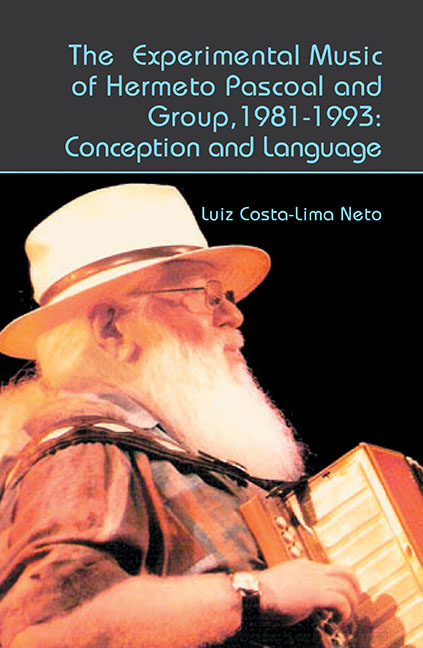Book contents
- Frontmatter
- Contents
- Miscellaneous Frontmatter
- Acknowledgments
- Introduction
- List of Illustrations
- Chapter 1 The conception and language of Hermeto Pascoal: first considerations
- Chapter 2 Bibliographic Discussion
- Chapter 3 The Creative Process Of Hermeto And Group
- Chapter 4 Reflections on Acoustics and Psycho-Acoustics
- Chapter 5 Selected Compositions For Analysis
- Conclusion
- Postscript
- Sources
- Plate section
Conclusion
- Frontmatter
- Contents
- Miscellaneous Frontmatter
- Acknowledgments
- Introduction
- List of Illustrations
- Chapter 1 The conception and language of Hermeto Pascoal: first considerations
- Chapter 2 Bibliographic Discussion
- Chapter 3 The Creative Process Of Hermeto And Group
- Chapter 4 Reflections on Acoustics and Psycho-Acoustics
- Chapter 5 Selected Compositions For Analysis
- Conclusion
- Postscript
- Sources
- Plate section
Summary
The creative act is mysterious… It is such a complex act, motivated by so many impulses - as remote and impersonal as the web of all known history and as remote and intensely personal as the sum of a man's entire experience—that the material evidence is little more than occasional glimpses of a profound, continuous process.
(Sloboda, 1985)This book has followed the direction indicated by Sloboda, i.e. the final product—in our case, the recordings of the pieces analyzed in the previous chapter—is the result of an anterior process. To analyze a certain musical corpus recorded by Hermeto Pascoal and Group between 1981 and 1993, I first went backwards in time to Hermeto Pascoal's childhood, and then followed his musical development until I once again reached the period I was aiming for at the outset. Furthermore, I provided a short biography of the musicians of the Group and reconstituted the creative process of Hermeto and Group, as well as each of the compositions that I analyzed. The analytical route that I have used is, from that point of view, quite simple. Through interviews with members of the Group and with Hermeto, I attempted to elucidate the genesis and the conception of a musical language.
Hermeto's interest in music began early. At the age of 7, in Lagoa da Canoa, he played the flutes with animals and struck small pieces of iron. At the age of 8, he began to play the eight-bass accordion and the tambourine with his brother at wedding parties and dances. It would be impossible to understand how Hermeto's musical conception originated without going back to his childhood, for his first musical experiences, which occurred between the ages of 7 and 14, and which were deeply absorbed by Hermeto. They offered him compositional and sound models that would reappear when he began his solo career at the age of 35.
Between the ages of 14 and 35, that is, for 21 years, Hermeto formed his musical language and developed autodidactically as a performer and an arranger, while at the same time coming into touch with instrumental formations, such as Regional radio groups, big bands and radio orchestras, besides learning several styles, while performing in radio stations and nightclubs in Recife, Rio and São Paulo.
- Type
- Chapter
- Information
- The Experimental Music of Hermeto Pascoal and Group, 1981–1993Conception and Language, pp. 145 - 146Publisher: Boydell & BrewerPrint publication year: 2015



